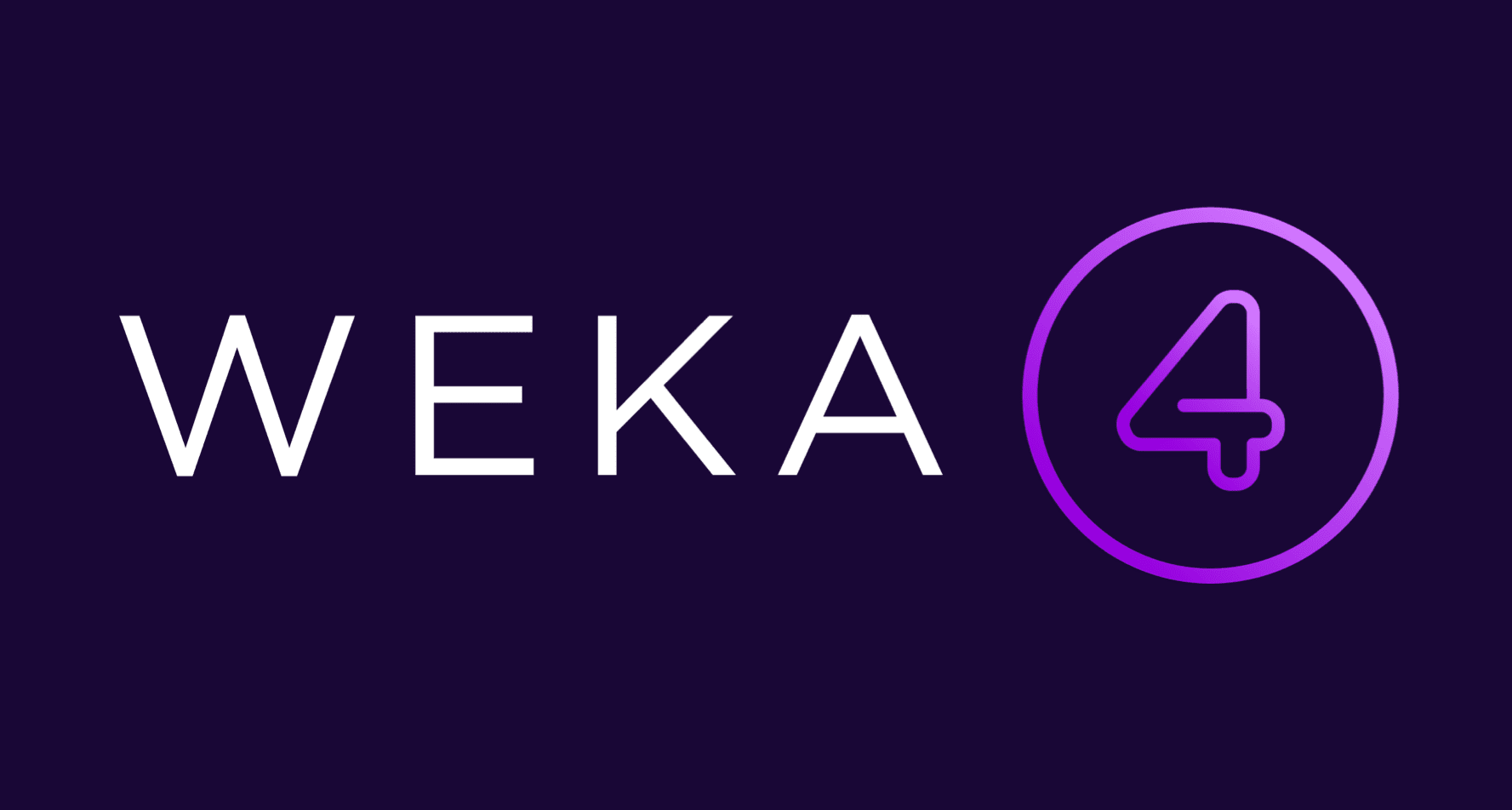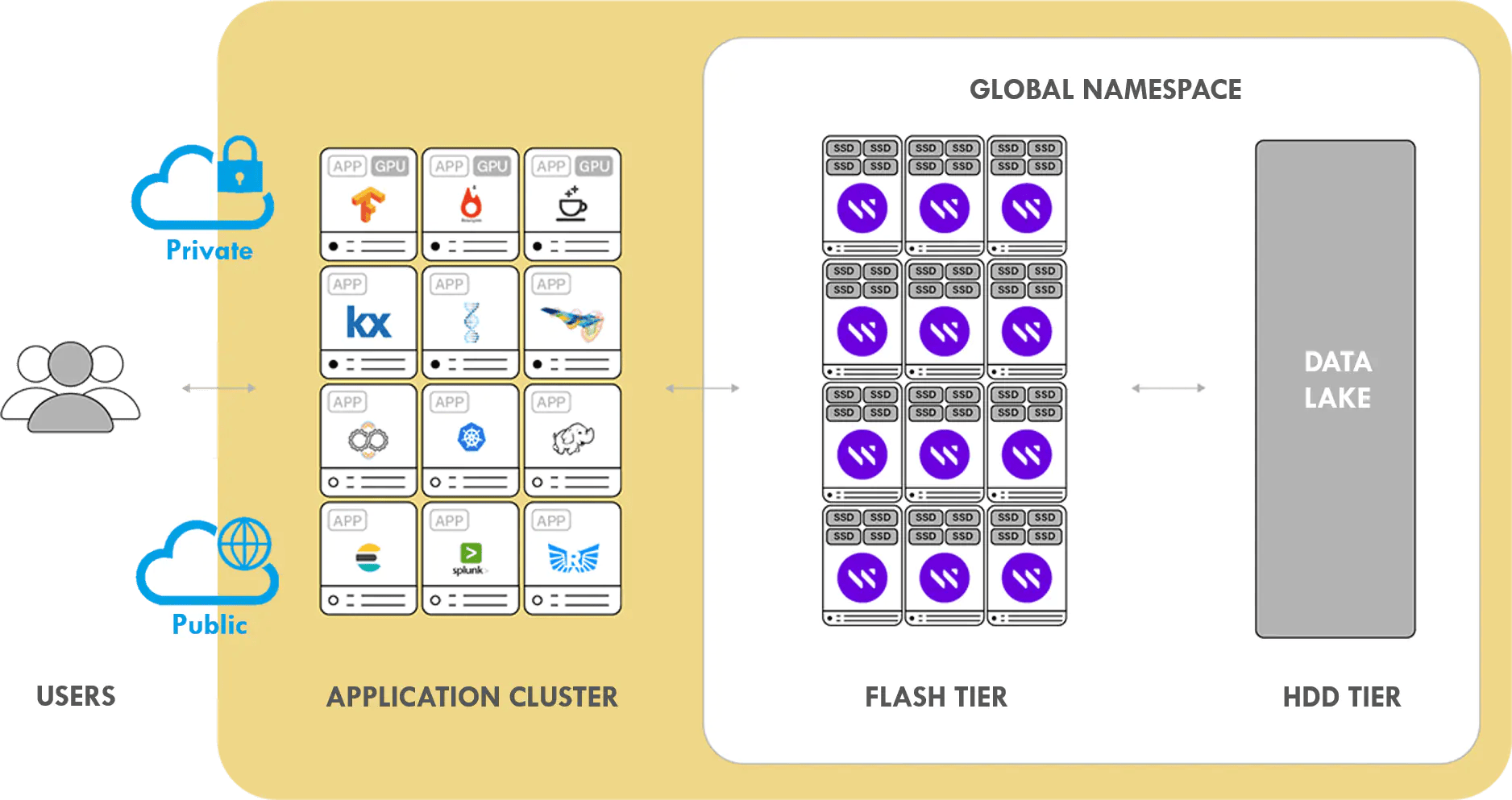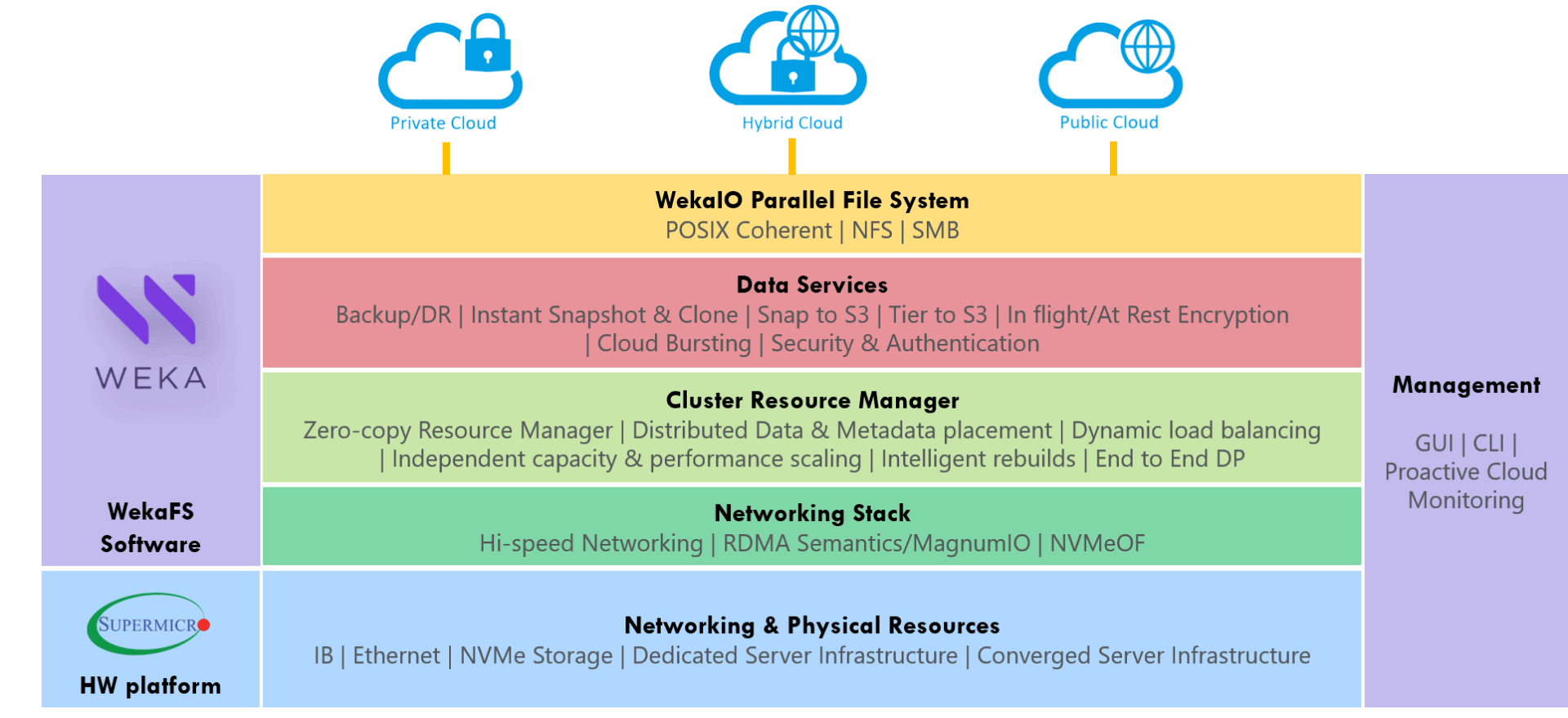WekaIO: High-Performance File System for Modern Workloads

In today's data-driven world, the ability to store and manage massive amounts of data efficiently and reliably is critical for businesses of all sizes. WekaIO is a high-performance file system that has been specifically designed to meet the demands of modern workloads, including big data, AI/ML, and high-performance computing. With its unique architecture and advanced features, WekaIO enables organizations to optimize their data storage and processing, accelerate application performance, and simplify data management. In this technical article, we will provide an in-depth overview of WekaIO, its architecture, functionality, and capabilities, and discuss how it can benefit technical specialists in their daily work.
WekaIO Architecture

WekaIO is a distributed, parallel file system that can scale from a few terabytes to multiple petabytes. It uses a unique, software-defined architecture that separates the data path from the control path, enabling it to achieve high performance, scalability, and resilience. WekaIO's architecture is based on a hybrid design that combines traditional file system metadata management with advanced object-based storage. This allows it to support a wide range of workloads, from small file I/O to large block I/O, and from sequential to random access.
Benefits of WekaIO
WekaIO offers several advantages over traditional file systems and other distributed file systems. First and foremost, it delivers high performance and low latency, even at scale. This is achieved through its use of advanced caching and tiering mechanisms, as well as its ability to take advantage of modern hardware, such as NVMe and RDMA. WekaIO also provides enterprise-grade features such as data protection, data reduction, and data management, including support for snapshots, replication, and encryption. In addition, it is easy to deploy, manage, and scale, with a simple web-based GUI and APIs that enable automation and integration with other tools and platforms.
Capabilities of WekaIO
WekaIO has a wide range of capabilities that make it an ideal choice for modern workloads. These include:
1. High-performance storage: WekaIO provides fast, low-latency access to data, making it ideal for high-performance computing, AI/ML, and big data workloads.
2. Scalability: WekaIO can scale from a few terabytes to multiple petabytes, and can handle millions of IOPS and throughput in the tens of gigabytes per second.
3. Data management: WekaIO includes advanced data management features such as snapshots, replication, and encryption, as well as support for multiple protocols, including NFS, SMB, and S3.
4. Cloud integration: WekaIO can be deployed in the cloud or on-premises, and can integrate with leading cloud platforms such as AWS, Azure, and Google Cloud.
5. Ease of use: WekaIO is easy to deploy, manage, and scale, with a simple web-based GUI and APIs that enable automation and integration with other tools and platforms.
Working with WekaIO File Systems

WekaIO provides a powerful and flexible solution for working with file systems, which enables technical specialists to optimize their data storage and processing workflows. Creating a new file system with WekaIO is a simple process that can be performed using a web-based GUI or a command-line interface. Mounting a WekaIO file system on client nodes is also straightforward, thanks to WekaIO's support for standard protocols such as NFS, SMB, and S3.
Creating a WekaIO File System
To create a new file system with WekaIO, the first step is to install the software on the desired nodes in the cluster. WekaIO supports both physical and virtual environments, including bare-metal servers, virtual machines, and cloud instances. Once the software is installed, the administrator can use the WekaIO Matrix Console, a web-based GUI, or the command-line interface (CLI) to create a new file system. The administrator must specify the size and performance characteristics of the file system, including the number of nodes, the amount of storage, and the type of storage devices, such as SSD or NVMe.
Mounting a WekaIO File System
After creating a new file system, the administrator can mount it on one or more client nodes. WekaIO supports several standard protocols, including NFS, SMB, and S3, which enable clients to access the file system from different types of operating systems and applications. To mount a file system, the administrator must specify the IP address or hostname of the node where the file system is located, as well as the mount point on the client node. WekaIO also provides advanced mount options, such as caching, security, and performance tuning, which can be customized to meet specific requirements.
Managing a WekaIO File System
WekaIO provides a comprehensive set of tools for managing file systems, including monitoring, troubleshooting, and optimization. The Matrix Console provides a real-time dashboard that displays key metrics, such as IOPS, throughput, latency, and capacity utilization, which enable administrators to monitor the health and performance of the file system. The CLI provides a set of commands for managing file systems, including creating and deleting snapshots, replicating data to remote locations, and configuring advanced features such as encryption and compression. WekaIO also supports integration with third-party tools, such as monitoring and analytics platforms, through APIs and plugins.
Scaling and Resource Management in WekaIO File Systems
One of the key advantages of WekaIO is its ability to scale seamlessly as the size and complexity of data workloads grow. WekaIO's software-defined architecture enables dynamic scaling of resources, including storage capacity, performance, and data protection, without disrupting ongoing operations. With WekaIO, administrators can add or remove nodes, storage devices, and file systems as needed, using a flexible pay-as-you-grow model that minimizes upfront costs and maximizes resource utilization.
WekaIO also provides seamless integration with cloud platforms, such as AWS, Azure, and Google Cloud, enabling organizations to leverage the benefits of cloud storage while maintaining control over their data workloads. WekaIO's cloud integration features include support for cloud-based storage services, such as Amazon S3 and Azure Blob Storage, as well as integration with cloud-based compute services, such as Amazon EC2 and Google Compute Engine. This integration enables organizations to take advantage of the scalability and flexibility of cloud platforms, while also ensuring that their data remains secure and accessible.
In addition to scaling, WekaIO provides a range of resource management tools that enable administrators to optimize performance and efficiency. For example, WekaIO's dynamic tiering feature automatically moves data between different tiers of storage, such as flash and disk, based on usage patterns and policies. This can help reduce costs and improve performance by ensuring that frequently accessed data is stored on faster, more expensive devices, while less frequently accessed data is moved to cheaper, slower devices.
Performance Optimization in WekaIO File Systems
To maximize the performance of a WekaIO file system, administrators can use a range of techniques to optimize various parameters and settings. For example, administrators can adjust the stripe size and number of stripes to optimize data access and transfer speeds. Additionally, WekaIO's distributed architecture enables administrators to balance the workload across nodes, which can help ensure that data is processed efficiently and that no single node becomes a bottleneck.
WekaIO also provides a range of caching options that enable administrators to optimize performance based on usage patterns and workload characteristics. For example, WekaIO's read-ahead caching can be used to prefetch data into cache, which can help reduce latency and improve response times for frequently accessed data. Similarly, WekaIO's write-back caching can be used to buffer writes to disk, which can improve performance by reducing the number of disk writes and consolidating small writes into larger, more efficient operations.
In addition to these techniques, WekaIO provides a range of monitoring and management tools that enable administrators to identify and address performance issues as they arise. For example, administrators can use WekaIO's real-time analytics dashboard to monitor key performance metrics, such as IOPS and throughput, and to identify performance bottlenecks. WekaIO also provides a range of APIs and integration options that enable administrators to automate performance management tasks and integrate with existing monitoring and management tools.
WekaIO and Big Data Tools
WekaIO's file systems also provide seamless integration with Hadoop and other big data processing tools, enabling organizations to use WekaIO as a high-performance data store for their big data workloads. WekaIO's distributed architecture and high-performance capabilities make it an ideal platform for storing and processing large volumes of data, while its Hadoop integration features enable organizations to take advantage of the scalability and flexibility of Hadoop, without sacrificing performance or data accessibility.
With WekaIO's Hadoop integration features, administrators can easily configure WekaIO file systems as Hadoop-compatible data stores, enabling Hadoop clusters to access and process data directly from WekaIO, without the need for additional data copies or ETL processes. Additionally, WekaIO's Hadoop integration features include support for popular Hadoop distributions, such as Cloudera, Hortonworks, and MapR, as well as support for Hadoop-compatible tools, such as Spark and Hive.
By using WekaIO as a data store for Hadoop and other big data processing tools, organizations can achieve significant performance and cost benefits, while also simplifying their data management workflows. WekaIO's distributed architecture and advanced caching and tiering capabilities ensure that data is always available and accessible, while its integrated management and monitoring tools enable administrators to optimize performance and resource usage across their data workloads
Finding and Fixing Errors in WekaIO
WekaIO's testing and debugging methods include a variety of tools and techniques that enable administrators and developers to monitor system performance, detect errors and failures, and diagnose and troubleshoot issues. These methods include log analysis, system monitoring and profiling, performance benchmarking, and error tracking and reporting.
Log analysis is an essential tool for detecting errors and failures in WekaIO systems. By analyzing system logs and event data, administrators can identify potential issues and take corrective actions before they impact system performance or data availability. System monitoring and profiling tools enable administrators to track system performance metrics, such as IOPS, throughput, and latency, and identify performance bottlenecks and areas for optimization.
Performance benchmarking is another critical aspect of WekaIO testing and debugging, enabling administrators to measure system performance under various workloads and configurations and identify areas for improvement. Benchmarking tests can include various scenarios, such as read and write operations, random and sequential access patterns, and different file sizes and types.
Error tracking and reporting tools are also essential for identifying and addressing issues in WekaIO systems. These tools enable administrators and developers to track and analyze system errors and failures, identify patterns and trends, and develop targeted fixes and patches.
Additional Solutions Offered by Supermicro with WekaIO
Supermicro offers a range of hardware solutions that are optimized to work seamlessly with WekaIO software. These solutions are designed to deliver the highest levels of performance and efficiency, while also providing enterprise-class data protection and management capabilities.
Some of the additional solutions offered by Supermicro with WekaIO include:
- SuperStorage Servers: Supermicro's SuperStorage servers are designed to provide the ultimate in storage density and performance. These servers feature a range of high-speed storage options, including NVMe SSDs and SAS3 HDDs, and can be configured with up to 24 drive bays. With WekaIO software, these servers can deliver high-performance, low-latency storage for a wide range of workloads.
- SuperBlade Servers: Supermicro's SuperBlade servers are designed for maximum density and scalability. These blade servers can be configured with a range of processors, memory, and storage options, and can be combined with WekaIO software to create high-performance, highly available storage solutions.
- SuperWorkstations: Supermicro's SuperWorkstations are designed to provide the ultimate in computing power and performance. These workstations feature the latest processors, graphics cards, and memory options, and can be combined with WekaIO software to deliver high-performance storage and compute solutions for demanding applications.
Development and Future of WekaIO
As WekaIO continues to grow and evolve, the company is committed to expanding its offerings and introducing new features and capabilities that enhance the performance, scalability, and flexibility of its file systems. With a focus on meeting the needs of customers in diverse industries and use cases, WekaIO is continually developing new solutions and tools that enable organizations to leverage the power of data to drive innovation and growth.
Some of the key areas of focus for WekaIO's future development include improving data management and automation capabilities, enhancing security and compliance features, and expanding integration with leading cloud and big data platforms. The company is also exploring new applications for its file systems, such as machine learning and AI, and developing new tools and solutions that enable organizations to extract greater insights and value from their data.
To support these efforts, WekaIO is investing heavily in research and development, partnering with leading technology providers, and collaborating with customers and industry experts to identify emerging trends and needs. The company's ongoing commitment to innovation and customer satisfaction ensures that WekaIO file systems will continue to be at the forefront of data storage and processing capabilities, enabling organizations to harness the power of data to drive business success.
WekaIO: High-Performance Storage Solutions
WekaIO provides high-performance storage solutions for enterprise-level organizations, enabling them to operate at any scale. With a range of advanced features like read-ahead caching and write-back caching, WekaIO can optimize performance based on usage patterns and workload characteristics, making it a top choice for businesses with heavy data workloads. Whether you need to store and process large amounts of data quickly or want to consolidate storage across multiple applications, WekaIO has a solution that can meet your needs.
With its advanced technology and flexible deployment options, WekaIO is a cost-effective solution for organizations that need high-performance storage without breaking the bank. And with support for popular cloud platforms like AWS and Google Cloud, WekaIO can easily integrate with your existing infrastructure to provide seamless storage and data management.

